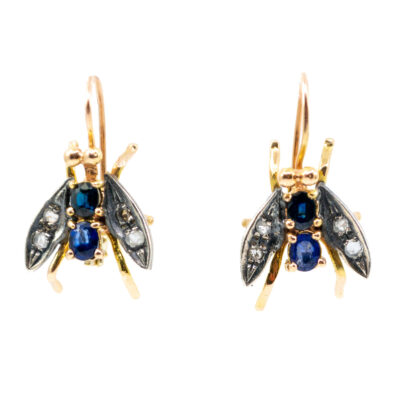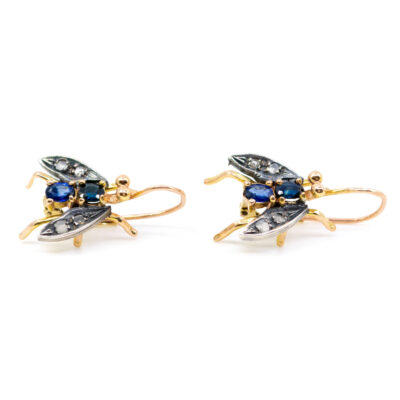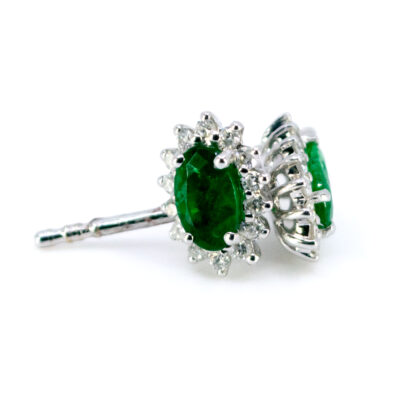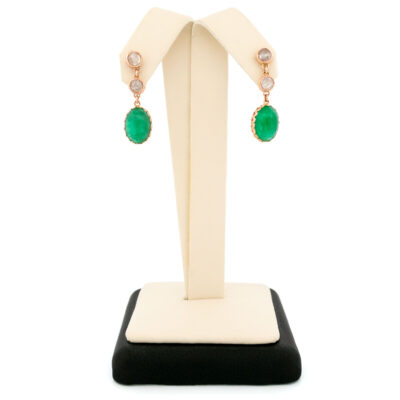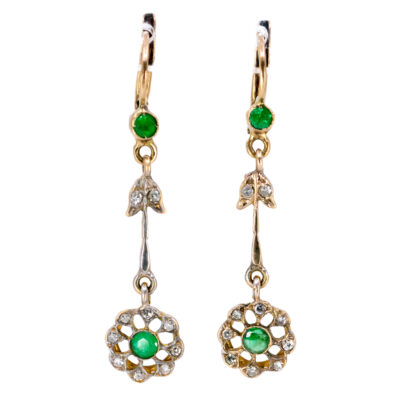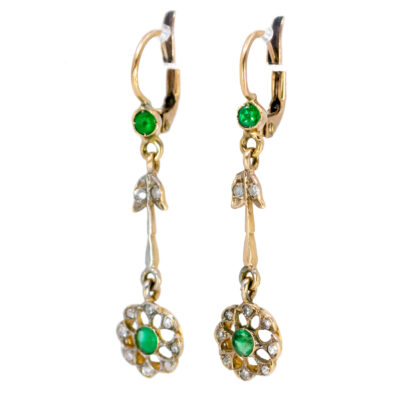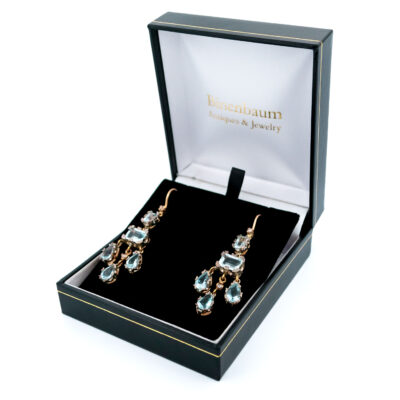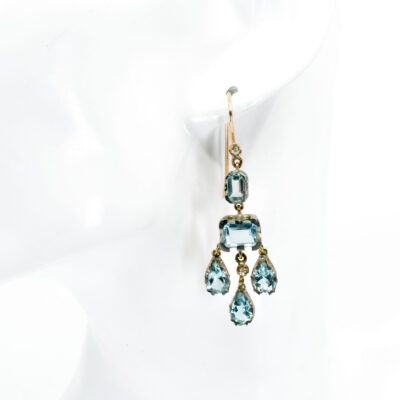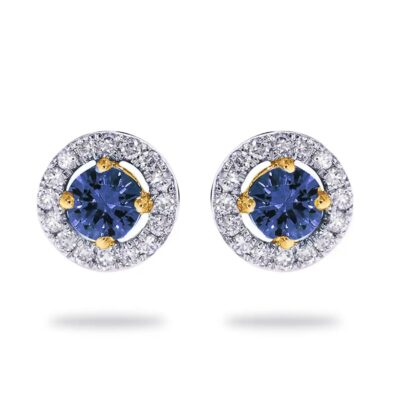Transform your look with these enchanting vintage Victorian-inspired insect earrings. The oval-shaped emeralds, approximately 1.00ct in weight, add a pop of lush green color to the design. They are further enhanced by the sparkling rose-cut diamonds, all set in a rich 9k gold setting.
Videos
Details: ±1.00ct Emerald, Rose-cut diamonds, 9k Earrings.
Design Era: New Victorian.
Dimensions: H 2.6 x L 1.6 cm.
Weight in grams: 5.8.
Condition: Very good condition – slightly used with small signs of wear.
Shipping and Pickup: This pretty piece ships from our store located in the center of Amsterdam, The Netherlands. We offer both registered shipping and local pickup at our store. In the case of local pickup, any applicable shipping costs will be refunded.
About Us: Add some sparkle to your style with Binenbaum.com. We offer a stunning selection of antique and vintage jewelry that you won’t find anywhere else. From timeless rings and dazzling necklaces to unique brooches, we have something for every taste and occasion. Visit our website today and treat yourself to a piece of history.
| Design Era | |
|---|---|
| Design & Historical Context | The Victorian Era spanned Queen Victoria's rule of England from 1837 until 1901. During this time, a middle class began to emerge, sparking a demand for jewelry in the mass market, jewelry trends often reflected the tone of current events. The era is usually divided into several subsections: the Romantic Period from 1837 to 1861, the Grand Period from 1861 to 1880, and the Aesthetic Period from 1880 to 1901. During the Romantic Period jewelry also featured nature-inspired designs, similar to jewelry of the Georgian era. Frequently, these designs were delicately and intricately etched into gold. Lockets and brooches were popular in daytime jewelry during the early Victorian era, whereas colored gemstones and diamonds were worn during the evening. During the Grand Period jewelry , because the Grand or Mid-Victorian era corresponded with the death of Queen Victoria's husband, many jewelry pieces have solemn, somber designs. Known as mourning jewelry, the pieces feature heavy, dark stones. Jet, onyx, amethyst, and garnet are frequently found in jewelry from this period. Compared to previous periods, Mid-Victorian-era jewelry features highly creative, colorful designs using shells, mosaics and gemstones. During the Aesthetic period, jewelers used diamonds and feminine, bright gemstones such as sapphire, peridot, and spinel. Star and crescent designs as well as elaborate hat pins were also popular. Some scholars believe the aesthetic era began sooner, in 1875, and ended as early as 1890. |
| Key Materials | |
| Materials & Craftsmanship | Emerald: The Jewel of Renewal and Prosperity Emerald, with its vibrant green hue, is one of the most prized gemstones in the world, belonging to the beryl family. Its captivating color, ranging from deep forest green to bright spring green, is due to the presence of chromium and vanadium during its formation. Emeralds have been cherished throughout history, from ancient Egyptian pharaohs who believed the stone symbolized eternal youth, to Incan and Aztec civilizations that revered it as a holy stone. In the Renaissance period, emeralds were thought to possess the power to predict the future and reveal truth. In modern jewelry, emeralds are admired for their rich color and elegance. Although they are slightly softer than other precious stones, with a Mohs hardness of 7.5 to 8, their beauty and rarity make them a popular choice for rings, necklaces, and earrings. Emeralds often feature characteristic inclusions, known as "jardin," which add to their uniqueness and charm. Emeralds symbolize renewal, growth, and prosperity, making them a timeless and meaningful choice for jewelry that exudes sophistication and natural beauty. Rose-cut diamond: The Vintage Gem of Romance and Light Rose-cut diamonds are a beautiful and romantic choice in the world of jewelry, known for their distinctive dome-shaped appearance and soft, glowing sparkle. This antique diamond cut, dating back to the 16th century, features a flat bottom and a domed top covered in triangular facets that resemble the petals of a rosebud—hence the name. Historically, rose-cut diamonds were highly prized during the Georgian and Victorian eras, often used in jewelry pieces meant to be worn in candlelight, where their gentle sparkle added a warm, intimate glow. Unlike modern brilliant cuts, which are designed for maximum fire and brilliance, rose-cut diamonds offer a more subdued, yet enchanting, reflection of light. In modern jewelry, rose-cut diamonds are cherished for their vintage appeal and unique charm. Their flat base and shallow profile make them perfect for creating low-profile, elegant designs that sit close to the skin, such as in rings, pendants, and earrings. Rose-cut diamonds are often used in vintage-inspired and bespoke pieces, where their historical elegance adds a touch of timeless romance. Rose-cut diamonds are more than just a gemstone choice; they are a symbol of understated beauty and classic romance. Their soft, luminous sparkle and antique allure make them an ideal choice for jewelry that tells a story and captures the essence of a bygone era. 9k: The Affordable and Durable Choice with a Subtle Golden Hue 9k gold is a cost-effective and sturdy option in the world of fine jewelry, particularly popular for those seeking the look of gold at a more accessible price point. The "9k" indicates that the gold is composed of 37.5% pure gold, with the remaining 62.5% made up of alloyed metals such as copper, silver, nickel, or zinc. This higher proportion of alloyed metals results in a more durable and harder material, making 9k gold an excellent choice for everyday wear. Historically, 9k gold has been favored in regions like the United Kingdom and Australia, where it is legally recognized as gold. It offers a balance between the luxury of gold and the practicality of more affordable metals, making it accessible to a wider range of people. In modern jewelry, 9k gold is appreciated for its durability and subtle color. While its gold content is lower than that of 14k or 18k gold, it still retains a warm, golden hue, though it is slightly paler. The color of 9k gold can vary depending on the metals used in the alloy: Yellow Gold: 9k yellow gold has a softer, more subdued golden color compared to higher karat golds, but it still carries the classic warmth and appeal of gold. White Gold: 9k white gold has a faint golden tint beneath its white finish, which is often enhanced with a rhodium plating to give it a brighter, more silvery appearance. Rose Gold: 9k rose gold, made by adding more copper to the alloy, has a delicate pinkish hue that is slightly more muted than higher karat rose golds but still carries a romantic charm. 9k gold is commonly used in rings, earrings, bracelets, pendants, and other jewelry that is designed for daily wear. Its increased durability means it is less prone to scratching and bending, making it a practical choice for pieces that are worn regularly. 9k gold is more than just an affordable alternative; it is a symbol of practical luxury and everyday elegance. Its durability, combined with its subtle and warm color, makes 9k gold a popular choice for those who want the beauty of gold with the added benefit of strength and affordability. Whether in a simple design or an intricate piece, 9k gold offers a lasting and attractive option for jewelry that can be cherished daily. |
| Dimensions | H 2.6 x L 1.6 cm |
| Gender | |
| Weight (in grams) | 5.8 |
| Condition | Very good condition – slightly used with small signs of wear |
By following these tips, you can enjoy your precious jewelry for many years to come.
Related Products
-
Diamond Sapphire 9k Silver Insect Earrings 14370-8318
€ 1.595,00 VAT incl. (where applicable) -
Emerald Diamond 18k Stud Earrings 12071-7324
€ 1.495,00 VAT incl. (where applicable) -
Diamond Emerald 14k Pendant Earrings 15523-8575
€ 3.395,00 VAT incl. (where applicable) -
Diamond Emerald 18k Drop Earrings 13194-5066
€ 1.595,00 VAT incl. (where applicable) -
Aquamarine Diamond 14k Chandelier Earrings 13551-8180
€ 1.900,00 VAT incl. (where applicable) -
Aquamarine Diamond 14k Platinum Drop Earrings 11806-6294
€ 3.995,00 VAT incl. (where applicable) -
Diamond Sapphire 14k Halo Earrings 17967-9364
€ 795,00 VAT incl. (where applicable) -
Diamond Sapphire 14k Entourage Earrings 17969-9366
€ 1.795,00 VAT incl. (where applicable)
- Home
- Collection
- Fine Jewelry
- Silver Jewelry
- Silverware
- Boxes
- Candlesticks
- Salt and pepper shakers
- Miniatures
- Salt cellars
- Spoon Set
- Condiments
- Frames
- Napkin Ring
- Spoon
- Oddities
- Cups
- Vases
- Cutlery
- Serving Spoon And Cake Server
- Candlesticks
- Baskets
- Hanukkiah
- Spice Tower
- Yad
- Tea Set
- Sugar Castor
- Napkin Rings
- Wine Bottle Coaster
- Wine Stopper
- Tea Pot
- Jugs
- Rattles
- Hip Flask
- Miscellaneous
- Rings 💍
- About
- Contact





